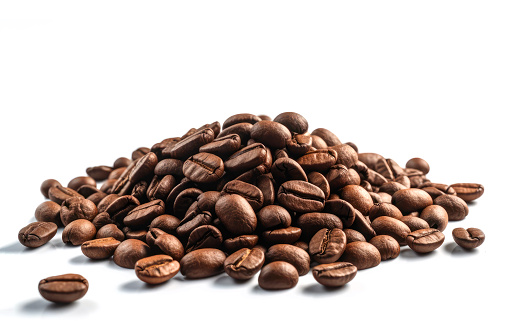Oil extraction
If one wants to produce coffee bean oil, both roasted and unroasted coffee beans can be used for this purpose.
Depending on the variety, water content and roasted or unroasted state, the stage of pre-treatment of the coffee beans before pressing differs. In general, they are gently heated to the pressing temperature and pressed by means of a mechanical pressing / oil press.
The products are thus cold-pressed coffee bean oil and, as a co-product, the high-quality coffee bean press cake.
The oil can also be obtained by extraction with dimethyl ether or petroleum ether. Before this, the seeds are often treated with tetrachloroethane to remove the wax they contain.
Properties and shelf life
Coffee bean oil from roasted beans is green to dark brown in color, while that from unroasted beans is light brown to yellow.
The oil from the roasted beans has the characteristic coffee odor, but that from the unroasted is almost odorless.
The melting point of coffee bean oil is about 8 – 9°C., which is why it is liquid at room temperature. Due to the high content of palmitic acid, however, it becomes solid again at a temperature of 3 – 11°C. (Solidification temperature: 3 – 11°C.)
Coffee bean oil is composed of about 8 – 10% oleic acid, about 36 – 43% linoleic acid and about 35 – 42% palmitic acid. It also contains about 7 – 11% stearic acid, about 4 – 7% arachidic acid and about 4 – 7% behenic acid. In addition to this rich fatty spectrum, the oil also contains many volatile substances, especially sterols such as β-sitosterol, stigmasterol and campesterol.
Based on an experiment on laboratory rats with green coffee bean oil, the toxic effect of coffee bean oil could be demonstrated.
The shelf life of this oil is about one year.
Use
In der Kosmetik
In cosmetics:
In the field of cosmetics, coffee bean oil finds its main application. It is suitable for the production of sunscreen products due to its particular composition (high degree of unsaponifiables, water-like density and sun-protective properties). It is also included in some moisturizers and body lotions, as it can increase skin hydration due to its high content of phytosterols. Because of this moisturizing property, it is also used, especially in India, for the production of soaps.
In the chemical industry
On the one hand, coffee bean oil is used in the chemical industry because of its high vitamin D content, and on the other hand, it is used to obtain sterols and sterol derivatives because of its high content of sterols.
We will be happy to advise you on this seed and show you options. Contact us
In addition to our own knowledge gained through pressing tests, the following sources were used to prepare this article:
- Öle, natürlich kaltgepresst, Basiswissen & Rezepte, Marcus Hartmann, Hädecke, 2008
- Heilende Öle, Pflanzenöle als Nahrungs- und Heilmittel, Neue Erkenntnisse, Günter Albert Ulmer Verlag Tuningen
- Lexikon der pflanzlichen Fette und Öle, Krist, Buchbauer, Klausberger, SpringerWienNewYork, 2008
- www.wikipedia.de
- en.wikipedia.org

